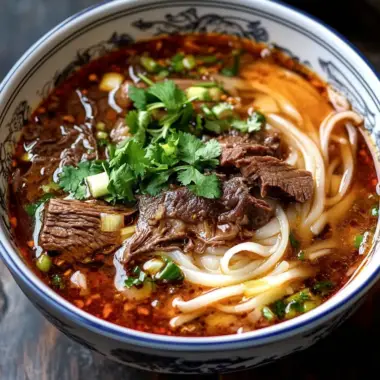The vibrant and rich Salmorejo is one of southern Spain’s most iconic summer dishes. With roots tracing back to Córdoba in Andalusia, this cold tomato and bread soup is a testament to how simple ingredients can be transformed into an elegant and flavorful dish. Made primarily from ripe tomatoes, day-old bread, garlic, and the golden goodness of extra virgin olive oil, Salmorejo delivers a creamy texture and an intense burst of Mediterranean flavor in every spoonful. Traditionally served chilled and topped with diced hard-boiled eggs and thin slices of cured Serrano ham, Salmorejo strikes a beautiful balance between rustic tradition and refined taste. Unlike its cousin gazpacho, which is lighter and chunkier, Salmorejo is thicker, smoother, and more indulgent making it perfect as an appetizer, a light meal, or part of a tapas spread. A true celebration of seasonal produce and Spanish culinary heritage, this dish is sure to cool you off and impress at any summer table.
Full Recipe:
Ingredients:
-
1 kg ripe tomatoes
-
200 g day-old white bread (crusts removed)
-
1 garlic clove
-
100 ml extra virgin olive oil
-
1 tablespoon sherry vinegar
-
Salt to taste
-
Optional toppings: diced hard-boiled egg, chopped Serrano ham, olive oil drizzle
Directions:
-
Wash and core the tomatoes. Cut them into chunks.
-
Blend the tomatoes in a food processor until smooth.
-
Tear the bread into small pieces and add to the blended tomatoes. Let it soak for 10 minutes.
-
Add garlic and sherry vinegar. Blend again until fully combined.
-
While blending, slowly drizzle in the olive oil to emulsify the soup.
-
Season with salt to taste.
-
Chill in the refrigerator for at least 2 hours before serving.
-
Serve cold with diced hard-boiled egg, chopped Serrano ham, and a drizzle of olive oil.
Prep Time: 15 minutes | Cooking Time: 0 minutes | Total Time: 2 hours 15 minutes (includes chilling)
Kcal: 270 kcal | Servings: 4 servings
Salmorejo: A Rich, Chilled Spanish Classic from Córdoba
Salmorejo is a traditional Spanish cold soup that originates from Córdoba, in the Andalusian region of southern Spain. Unlike gazpacho, which many people might already be familiar with, salmorejo is thicker, creamier, and heartier, with a luxurious mouthfeel that elevates it from a simple soup to a gourmet starter or even a light meal. It’s a popular dish particularly in the scorching summer months, when cold, fresh, and nourishing food is not just appreciated but essential.
Made with a short list of humble ingredients ripe tomatoes, day-old white bread, garlic, olive oil, and sherry vinegar salmorejo is a testament to the resourcefulness and ingenuity of Andalusian cuisine. Despite its simplicity, the soup is deeply flavorful and satisfying, with a naturally creamy texture achieved without any dairy. This makes it a brilliant option for those who are lactose-intolerant or following plant-based diets.
In this article, we’ll dive deeper into the origins of salmorejo, what makes it so special, how it compares to similar dishes, and why it deserves a permanent place on your summer menu.
The Origins of Salmorejo
Salmorejo has ancient roots in the Andalusian region of Spain. Its development is thought to be connected to the Roman occupation of the Iberian Peninsula, when bread was often used as a thickener for soups and stews. Over centuries, local cooks refined the dish, particularly in Córdoba, giving rise to what we now know as salmorejo a blend of raw tomatoes, soaked bread, garlic, and olive oil emulsified into a smooth, cold soup.
What’s particularly fascinating about salmorejo is how it reflects Andalusia’s historical climate, agriculture, and social fabric. The hot Mediterranean climate calls for cooling dishes, and the abundance of ripe tomatoes and quality olive oil makes this region ideal for a dish like salmorejo to flourish. It was a frugal meal for the working class and has since become a culinary icon in both traditional and modern Spanish cuisine.
How Salmorejo Differs from Gazpacho
Salmorejo and gazpacho are often compared due to their shared ingredients and status as Spanish cold soups. However, they are quite distinct in both taste and texture.
Gazpacho is typically thinner, more watery, and contains a wider range of vegetables such as cucumbers, green peppers, and onions. It has a refreshing, tangy flavor profile that makes it ideal as a drinkable soup or aperitif.
Salmorejo, on the other hand, uses only a few core ingredients, with bread making up a significant portion of its body. This results in a much thicker and silkier consistency. It’s served in a bowl and often garnished with hard-boiled eggs and jamón Serrano (Spanish cured ham), which add richness and protein.
The experience of eating salmorejo is more akin to enjoying a light, cold purée, and its concentrated flavor makes it feel much more indulgent and filling.
The Art of Simplicity: Why Ingredients Matter
Because salmorejo has so few ingredients, the quality of each one is absolutely crucial. Starting with ripe, juicy tomatoes is key they are the star of the show, bringing natural sweetness, acidity, and color. Traditionally, Spanish cooks would use varieties like tomate pera or vine-ripened tomatoes grown in the Andalusian sun.
The bread, ideally a day or two old and made from white wheat flour, helps create that signature velvety texture. Authentic recipes often call for a rustic Spanish loaf, though any crustless, dense bread will work.
Then there’s the olive oil. This is what transforms the dish from a simple purée into a silky soup. Spanish extra virgin olive oil, with its fruity and peppery notes, provides depth and emulsifies beautifully with the tomato base.
A touch of sherry vinegar brightens the flavors and gives the soup its signature tang, while garlic adds a pungent kick without overpowering the natural taste of the tomatoes.
Traditional Toppings and Serving Ideas
A hallmark of a well-served salmorejo is the garnish. Classic toppings include diced hard-boiled eggs and finely chopped jamón Serrano. These additions bring a rich contrast to the cool, creamy soup, adding both texture and protein. A drizzle of good-quality olive oil is often added at the end for extra gloss and flavor.
However, the toppings can be easily adapted to suit dietary needs. For a vegetarian version, you can skip the ham or use smoked paprika-dusted croutons or roasted chickpeas. For a vegan twist, substitute the eggs with marinated tofu or simply leave them out the soup is rich enough to stand on its own.
Salmorejo is best served chilled, making it an excellent choice for summer lunches, light dinners, or as a first course during dinner parties. It’s also a perfect addition to a tapas spread, allowing guests to enjoy a small but memorable taste of Andalusia.
Nutritional Value and Dietary Benefits
Salmorejo may be rich in flavor, but it’s also surprisingly nutritious. Tomatoes are high in vitamin C, potassium, folate, and lycopene a powerful antioxidant linked to heart health and cancer prevention. Olive oil provides healthy fats and anti-inflammatory benefits, while garlic contributes to immune health and blood pressure regulation.
Because there’s no cream or meat in the base recipe, salmorejo is naturally vegetarian and can easily be adapted for vegan diets. It’s also low in sugar and can be gluten-free if made with gluten-free bread.
It’s a dish that satisfies both the palate and the body, proving that delicious food doesn’t need to be complicated or unhealthy.
Salmorejo in Modern Cuisine
In recent years, salmorejo has experienced a revival not just in Spain, but globally, as part of the larger trend toward clean, whole-foods cooking. Renowned chefs across Europe and the Americas have embraced the dish, reinterpreting it with creative twists like beetroot-infused salmorejo, avocado-topped versions, or even miniature salmorejo shooters served at high-end events.
This growing appreciation speaks to the dish’s adaptability and universal appeal. Whether you serve it in a rustic ceramic bowl or as a plated gourmet starter, salmorejo effortlessly bridges traditional and contemporary culinary styles.
Cultural Significance and Culinary Heritage
Beyond its ingredients and flavor, salmorejo carries with it a cultural identity that’s deeply rooted in Andalusian life. It’s a dish passed down through generations, often made by grandmothers and mothers as part of family traditions. In Córdoba, it’s not uncommon to find it served at festivals, markets, and gatherings as a symbol of local pride.
In many ways, salmorejo embodies the essence of Spanish home cooking simple, seasonal, and soulful. Eating it is like taking a bite out of Spanish history and hospitality, making it much more than just a recipe it’s an experience.
Conclusion:
If you’ve never tried salmorejo, there’s no better time than summer to do so. It’s a dish that showcases how a handful of quality ingredients can come together to create something greater than the sum of its parts. Creamy without cream, rich without meat, and refreshing without ice, salmorejo is pure Spanish sunshine in a bowl.
It invites you to slow down and savor each spoonful, to appreciate the natural flavors of ripe tomatoes and the subtle alchemy that occurs when bread and oil are emulsified into something luxuriously smooth. Whether you’re hosting a summer dinner party, looking for a make-ahead meal, or simply wanting to explore Spanish cuisine from home, salmorejo is a standout choice that’s both comforting and refined.








